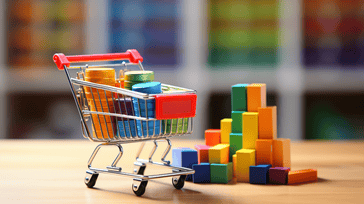

Consumer confidence is a crucial economic indicator that measures the level of optimism consumers have about the overall state of the economy. It reflects their current and future financial outlook, which in turn impacts their spending patterns and behavior. As such, consumer confidence is an important measure for policymakers, businesses, and investors to assess the direction and overall health of the economy.
Changes in consumer sentiment can influence various economic indicators, and understanding the links between consumer confidence and these indicators is crucial for making informed decisions. In this section, we will explore the importance of consumer confidence as an economic indicator, its impact on spending trends, and its influence on other key economic measures.
Gross Domestic Product (GDP) is a primary indicator of economic growth, estimating the total value of goods and services produced in a country. As consumer spending accounts for two-thirds of GDP, consumer confidence plays a significant role in determining the direction of the economy. Consumer confidence refers to consumers' perceptions of current and future economic conditions, including job security, income level, and overall financial well-being.
A high level of consumer confidence leads to increased consumer spending, which eventually boosts economic growth and vice versa. A strong correlation between consumer confidence and GDP growth is observed when comparing historical data from the last few decades.
A table comparing the GDP growth rate and consumer confidence index over the last ten years is shown below:
| Year | GDP Growth Rate (%) | Consumer Confidence Index |
|---|---|---|
| 2010 | 2.5 | 53.7 |
| 2011 | 1.6 | 60.1 |
| 2012 | 2.2 | 68.5 |
| 2013 | 1.8 | 72.3 |
| 2014 | 2.4 | 86.0 |
| 2015 | 2.9 | 98.2 |
| 2016 | 1.6 | 98.5 |
| 2017 | 2.2 | 101.4 |
| 2018 | 2.9 | 98.3 |
| 2019 | 2.2 | 128.2 |
The above table shows that consumer confidence and GDP growth rates generally move in the same direction. When consumer confidence is high, GDP growth tends to be high, and when consumer confidence is low, GDP growth tends to be low. The exception to this trend is seen in 2016 when GDP growth was lower than expected, despite high consumer confidence levels. This anomaly can be attributed to external factors such as global economic uncertainty and unfavorable weather conditions.
The table data supports the argument that increases in consumer confidence can lead to increased economic growth, and policymakers and businesses can use this relationship to make informed decisions. By understanding the interplay between consumer confidence and GDP growth, policymakers can tailor their economic policies to foster increased consumer spending and, ultimately, drive economic growth.

Consumer confidence and unemployment rates are interconnected. When people feel secure in their jobs, they are more likely to spend money, which can stimulate economic growth. Conversely, job insecurity can lead to a decrease in spending and a slowdown in economic activity. Therefore, understanding the relationship between the unemployment rate and consumer confidence is crucial for policymakers, investors, and businesses.
"Unemployment is 'negative' spending, and consumer confidence is 'positive' spending. When unemployment rates rise, consumer confidence decreases, and when unemployment rates fall, consumer confidence increases."
Historically, low unemployment rates have been associated with high levels of consumer confidence. When people feel secure in their jobs and have a positive outlook for the future, they are more likely to spend money on goods and services. This, in turn, can boost economic growth and lead to job creation. The opposite is also true; high rates of unemployment can lead to lower levels of consumer confidence and a decrease in spending. This can cause a ripple effect, leading to layoffs, more unemployment, and a further reduction in consumer confidence.
It is essential to note that there is a feedback loop between consumer confidence and the unemployment rate. When the unemployment rate increases, consumer confidence tends to decrease. This, in turn, can lead to a reduction in spending, which can cause businesses to lay off workers, resulting in higher unemployment rates. As such, policymakers often focus on finding ways to stimulate the creation of new jobs and reduce unemployment rates to maintain consumer confidence and boost economic growth.
The COVID-19 pandemic has had a significant impact on both unemployment rates and consumer confidence. As businesses have shut down, millions of people have lost their jobs, leading to a massive increase in unemployment rates. In turn, this has led to a decrease in consumer confidence, as people are uncertain about their financial futures. For many, the economic impacts of the pandemic have been devastating, and it may take years for the economy to recover fully.
The relationship between the unemployment rate and consumer confidence is complex and interdependent. Policymakers, businesses, and investors must monitor both indicators closely to make informed decisions that support economic growth and stability. By creating policies that promote job creation and reduce unemployment rates, policymakers can help maintain and increase consumer confidence, leading to sustained economic growth.
Consumer confidence and the inflation rate are closely linked. Changes in consumer sentiment can have a significant impact on consumer spending, which in turn can affect the demand-supply dynamics of the economy. Additionally, inflationary expectations can influence consumer confidence levels, which can further influence the inflation rate.
When consumers have a positive outlook and feel confident about the economy, they are more likely to spend money. This increase in spending can lead to an increase in demand for goods and services, which can subsequently drive up prices and contribute to inflation. Conversely, when consumers are pessimistic about the economy, they are more likely to save their money, which can lead to a decrease in demand, lower prices and deflation.
It is worth noting that inflationary expectations can also influence consumer confidence. If consumers expect prices to increase in the future, they may feel less confident in the economy and reduce their spending accordingly. On the other hand, if they expect prices to remain stable or even decrease, they may feel more confident and increase their spending.
| Year | Inflation Rate | Consumer Confidence Index |
|---|---|---|
| 2015 | 2.1% | 95.4 |
| 2016 | 2.5% | 93.8 |
| 2017 | 2.1% | 98.4 |
| 2018 | 2.4% | 91.2 |
"As we can see from the table above, in 2017, there was a positive correlation between inflation and consumer confidence. As inflation remained stable, the consumer confidence index increased. However, in 2018, we can observe a negative correlation between inflation and consumer confidence. As inflation rose, consumer confidence fell."
The relationship between consumer confidence and the inflation rate is complex and can be influenced by a variety of factors. However, understanding this relationship is essential for policymakers, businesses, and investors who need to make informed decisions based on the state of the economy.

Consumer spending is a significant driver of the economy. Fluctuations in spending patterns can impact various economic indicators, including but not limited to GDP, employment, inflation, and manufacturing. Let's explore how consumer spending affects these economic indicators:
| Economic Indicator | Impact of Consumer Spending |
|---|---|
| GDP | Consumer spending accounts for approximately 70% of GDP. Therefore, any changes in consumer spending, whether increases or decreases, can have a significant impact on the overall economic output. |
| Employment | Increased consumer spending can stimulate demand for goods and services, leading to job creation. Conversely, decreased consumer spending can cause businesses to cut back on hiring or even lay off workers, contributing to an increase in the unemployment rate. |
| Inflation | Consumer spending can also affect the demand-supply dynamics in the economy. Increased consumer spending can lead to higher demand for goods and services, causing prices to rise (inflation). On the other hand, decreased consumer spending can lead to lower demand and lower prices (deflation). |
| Manufacturing | The manufacturing sector's health relies on consumer demand for manufactured products. Higher consumer spending on goods can lead to increased production and manufacturing activity, contributing to a positive manufacturing index. Conversely, decreased consumer spending can cause a decrease in demand for manufactured goods and a corresponding drop in the manufacturing index. |
As we can see, consumer spending plays a crucial role in shaping various economic indicators. Policymakers, businesses, and investors must closely monitor consumer spending patterns to understand the direction and health of the economy. By analyzing changes in consumer spending, stakeholders can make informed decisions about fiscal and monetary policies, business strategies, and investment opportunities.
Interest rates play a crucial role in the economy and are closely linked to consumer confidence. When interest rates are high, consumers tend to save more, and borrowing costs increase, leading to a decrease in spending. Conversely, lower interest rates can stimulate spending, making it easier for consumers to borrow money for purchases such as homes, cars, or college education.
Central banks and policymakers have a significant influence on interest rates. They may choose to lower rates to encourage spending during a recession, or raise them to cool down an overheated economy. These decisions, in turn, impact consumer borrowing costs and behavior, which can affect consumer confidence levels.
"Interest rates are a key factor for consumers when making financial decisions. Higher interest rates can impact consumer sentiment and lead to lower spending, while lower interest rates can stimulate growth and confidence."
When interest rates are at historic lows, consumers typically feel more confident about spending because they have more disposable income. This can lead to increased demand for goods and services, which can ultimately boost economic growth. On the other hand, when interest rates are high, consumers may shy away from making large purchases, leading to a decrease in economic activity.
The relationship between interest rates and consumer confidence is complex and multi-faceted. However, by understanding this dynamic, businesses and investors can take advantage of opportunities and anticipate challenges in the market.

Consumer confidence is a key influencer of the stock market performance. When consumer sentiment is positive, people tend to spend more money, which can lead to an increase in corporate profits. Higher corporate profits can, in turn, lead to higher stock prices. Conversely, when consumer confidence is low, people tend to save their money, which can lead to lower corporate profits and, in turn, lower stock prices.
"The stock market is filled with individuals who know the price of everything, but the value of nothing." - Phillip Fisher
Indeed, consumer confidence is a major factor influencing investor behavior and market sentiment. When consumers feel optimistic about the economy, investors tend to become more bullish and may buy more stocks. On the other hand, if consumers are pessimistic, investors may become more bearish and sell off their stocks.
Consumer confidence can also affect individual companies' stock performance. For example, if a company is known for producing luxury goods, its stock price may be negatively impacted during times of low consumer confidence as people may not be willing to spend extra money on such items.
It's worth noting, however, that stock market performance does not always align with the economy's health. In some cases, the stock market may continue to rise despite low consumer confidence and weak economic indicators. This phenomenon can be attributed to factors such as monetary policy, interest rates, and investor sentiment.
The manufacturing index and consumer confidence have a symbiotic relationship in the economy. Changes in consumer sentiment can directly impact demand for manufactured goods, which can, in turn, influence the manufacturing index. By analyzing this relationship, we can gain insights into the broader health of the economy.
When consumer confidence is high, individuals are more likely to purchase goods, including manufactured products. This increased demand can cause an uptick in the manufacturing index, indicating growth in the sector. On the other hand, when consumer confidence is low, individuals may cut back on discretionary spending, which can result in a decrease in demand for manufactured goods and a decrease in the manufacturing index.
For example, during the COVID-19 pandemic, many consumers were uncertain about the future and cut back on spending. As a result, the manufacturing index saw a significant decline, as demand for goods decreased.
Furthermore, the manufacturing index can impact consumer confidence. When the index is high, it can signal growth in the economy, which can increase consumer confidence. On the other hand, a decrease in the manufacturing index can result in decreased confidence in the economy, as individuals may worry about job security and economic stability.
A visual representation of the relationship between the manufacturing index and consumer confidence can be seen in the table below:
| High Consumer Confidence | Low Consumer Confidence | |
|---|---|---|
| High Manufacturing Index | Increase in demand for goods Increase in consumer confidence |
Stable demand for goods Decrease in consumer confidence |
| Low Manufacturing Index | Stable demand for goods Moderate increase in consumer confidence |
Decrease in demand for goods Decrease in consumer confidence |
As can be seen from the table, a healthy manufacturing sector can positively impact consumer confidence, while a decline in the industry can result in decreased confidence and demand for goods.
In conclusion, understanding consumer confidence and its impact on various economic indicators is crucial for policymakers, businesses, and investors. Consumer sentiment influences GDP growth, the unemployment rate, inflation, consumer spending, stock market performance, and the manufacturing index.
By analyzing spending trends and consumer behavior, policymakers can make informed decisions about fiscal and monetary policies. Businesses can use consumer confidence as a leading indicator to adjust their marketing strategies and invest in projects accordingly. Investors can use this knowledge to make informed decisions about stock market investments.
Consumer confidence is a critical economic indicator that can provide valuable insights into the overall health and direction of the economy. Monitoring changes in consumer sentiment and their impact on economic indicators is necessary for anyone looking to make informed decisions in the business world.
Consumer confidence refers to the degree of optimism or pessimism that consumers have about the state of the economy and their personal financial situation. It is a measure of how confident consumers feel about spending money and making big-ticket purchases.
Consumer confidence is important as an economic indicator because it can provide insights into future consumer spending behavior. High levels of consumer confidence indicate that consumers are more likely to spend, which can boost economic growth. Conversely, low levels of consumer confidence can signal potential economic downturns or reduced spending.
Consumer confidence can significantly impact GDP growth. When consumer sentiment is high, people tend to spend more, leading to increased demand for goods and services. This increased spending stimulates economic growth and can contribute to higher GDP growth rates.
Consumer confidence and the unemployment rate are closely interconnected. High consumer confidence levels can signal increased job security and stability, as well as a positive economic outlook. Conversely, low consumer confidence can be an indication of underlying concerns about job prospects and can potentially lead to higher unemployment rates.
Consumer confidence can impact the inflation rate through its influence on consumer spending. When consumer confidence is high, people are more likely to spend money, which can create increased demand for goods and services. This increased demand can lead to higher prices and potentially contribute to inflationary pressure.
Consumer spending is a crucial component of various economic indicators, including GDP, employment, and inflation. Changes in consumer behavior, such as increased or decreased spending, can have significant effects on these indicators. Consumer spending patterns provide insights into the overall state of the economy and can help economists, policymakers, and businesses make informed decisions.
Interest rates can impact consumer confidence by affecting borrowing costs. When interest rates are low, it becomes cheaper to borrow money, which can stimulate consumer spending and confidence. Conversely, high-interest rates can increase borrowing costs, potentially discouraging consumers from making big purchases and leading to lower confidence levels.
Consumer confidence can influence stock market performance. When consumer confidence is high, consumers are more likely to invest in the stock market, leading to increased demand for stocks and potentially driving up prices. Conversely, low consumer confidence can result in decreased investor optimism, which may contribute to declining stock prices.
Consumer confidence can impact the manufacturing index by influencing demand for manufactured goods. When consumer confidence is high, people are more likely to spend on durable goods, which can drive up demand for manufactured products. This increased demand can contribute to higher manufacturing activity and boost the manufacturing index.
Copyright © 2024 Omened Invest. All rights by Omened Invest.